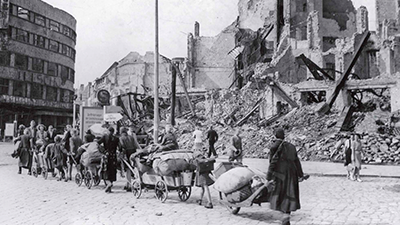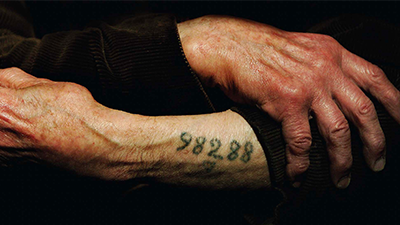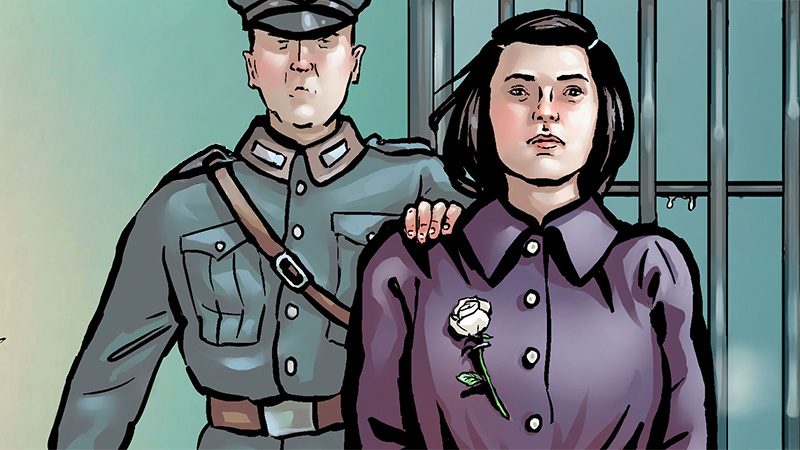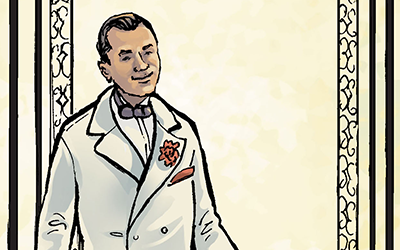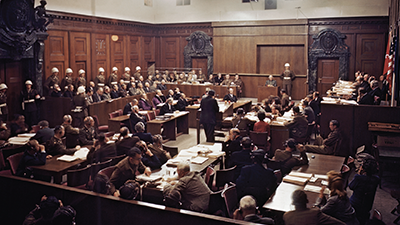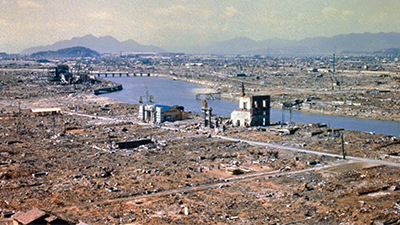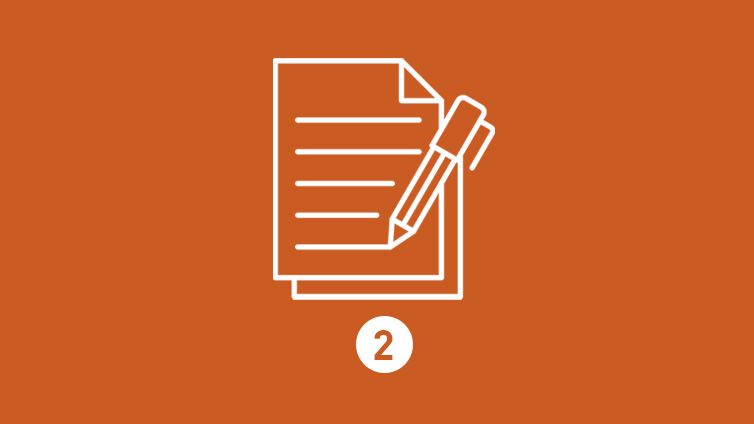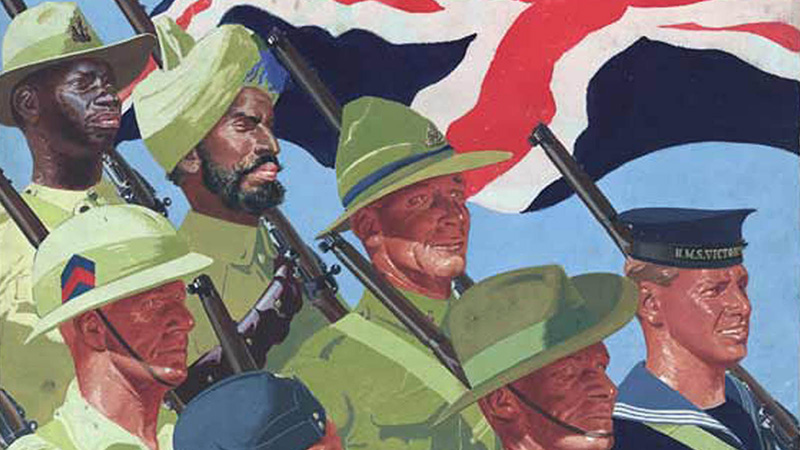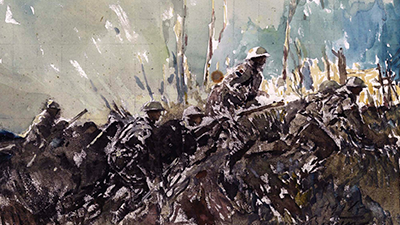World War II: The Costs
Teacher Resources
Driving Question: What were the consequences of World War II?
The cost of World War II can’t be measured in numbers alone. This lesson explores the human toll of global war and the birth of nuclear-age diplomacy.
Learning Objectives:
- Use evidence to support and evaluate claims about global conflict.
- Use the historical thinking practice of comparison to evaluate continuities between the First and Second World Wars.
- Use evidence to explore how people and nations experienced, remembered, and responded to the costs of World War II.
Vocab Terms:
- antisemitism
- casualty
- diplomacy
- extermination camps
- genocide
- ghetto
Opener: World War II: The Costs
To teach this lesson step, refer to page 3 of the Lesson 7.8 Teaching Guide.
Begin your exploration of the Holocaust by reflecting on how individual voices and choices shape history. This activity introduces major themes of the lesson and sets the stage for deeper investigation into the causes and consequences of genocide.
A Shattered World
To teach this lesson step, refer to page 3 of the Lesson 7.8 Teaching Guide.
World War II left behind devastation on a scale the world had never seen. With these materials, you'll examine the staggering human cost of the war and explore the idea that the First and Second World Wars were part of a single, decades-long conflict.
-
Guiding Questions
-
Before you watch
Preview the questions below, and then review the transcript.
While you watch
Look for answers to these questions:
- How did military and civilian casualties differ during the war?
- Which country lost the most soldiers and civilians in the war, and why?
- Which side intentionally targeted civilians?
- Was World War II the deadliest war in history?
- What is meant by “The Long Peace”?
After you watch
Respond to this question: Why do you think major wars have become less frequent and less deadly since World War II?
Key Ideas
-
Guiding Questions
-
Before you read
Preview the questions below, and then skim the article. Be sure to look at the section headings and any images.
While you read
Look for answers to these questions:
- How did nationalism connect World War I and World War II?
- What role did empires and colonialism play across both wars?
- How did the post–World War I treatment of Germany contribute to the outbreak of World War II?
After you read
Respond to these questions: Do you think viewing 1914 to 1945 as one long war helps us better understand the causes and consequences of global conflict? Why or why not?
Never Again
To teach this lesson step, refer to page 8 of the Lesson 7.8 Teaching Guide.
These materials explore the policies, people, and decisions that made the Holocaust possible. Through personal accounts, legal responses, and global debates, you’ll examine how societies remember violence, assign responsibility, and defend human rights.
-
Guiding Questions
-
Before you read
Preview the questions below, and then skim the article. Be sure to look at the section headings and any images.
While you read
Look for answers to these questions:
- What laws and policies helped legalize the persecution of Jewish Germans?
- What was Kristallnacht?
- What was the T4 program?
- Who carried out the actions of the Holocaust?
- Why did some women support fascist regimes, even when those regimes restricted their rights?
After you read
Respond to this question: Using the communities frame, how can we explain some of the causes and effects of the Holocaust?
-
Guiding Questions
-
Before you read
Preview the questions below, and then skim the comic, paying attention to things like prominent colors, shapes, and types of text and fonts. How do you know where to start and in which direction to read? What’s in the gutters (the space between panels)? Who or what is the focus of the comic?
While you read
- Why did Sophie and her brother become disenchanted with the Nazi regime?
- How did the White Rose resist the Nazi government?
- Why is the White Rose still commemorated today?
- How does the artist use art and design to tell the story of the White Rose and their acts of resistance during World War II?
After you read
Respond to this question: Do you think the form of resistance that Sophie and the White Rose engaged in was effective? Why or why not?
-
Guiding Questions
-
Before you read
Preview the questions below, and then skim the comic, paying attention to things like prominent colors, shapes, and types of text and fonts. How do you know where to start and in which direction to read? What’s in the gutters (the space between panels)? Who or what is the focus of the comic?
While you read
- What country did Manuel Quezon lead in 1935?
- Why did he welcome Jewish refugees that year?
- What shows that Quezon was guided by his conscience?
- What does the artist mean by calling immigration restrictions a “paper wall”?
- How does the artwork show Quezon moving that wall aside?
After you read
Respond to this question: How does Quezon’s story add to your understanding of the Holocaust and the choices individuals made during World War II?
-
Guiding Questions
-
Before you read
Preview the questions below, and then skim the article. Be sure to look at the section headings and any images.
While you read
Look for answers to these questions:
- What is the “paradox of human rights”?
- What were the Nuremberg Trials?
- Why were the Nuremberg Trials different from earlier trials?
- What were the Nuremberg Principles?
- How did the trials influence the growth of human rights?
After you read
Respond to these questions: Considering the community frame narrative for this course, do you think there is such a thing as an “international community”? Why or why not?
The Bomb
To teach this lesson step, refer to page 11 of the Lesson 7.8 Teaching Guide.
The atomic bombs dropped on Hiroshima and Nagasaki ended the Second World War, but at an enormous human cost. Consider multiple historical perspectives on why the bombs were used, and evaluate their impact on war, diplomacy, and the modern world.
-
Guiding Questions
-
Before you read
Preview the questions below, and then skim the article. Be sure to look at the section headings and any images.
While you read
Look for answers to these questions:
- How did nuclear science reach the United States before the bombs were developed?
- What is one argument for why President Truman decided to drop the atomic bombs?
- What alternative explanation does Gar Alperovitz offer for Truman’s decision?
- According to Hasegawa, what led Japan to surrender?
- Besides destruction, what other global consequences resulted from the development of nuclear weapons?
After you read
Respond to this question: Which explanation for the use of atomic bombs do you find most convincing, and why?
Reflections on Global Conflict
Use this informal writing opportunity to connect what you’ve learned about the First World War to big ideas in the course. Consider how conflict, governance, and global connections shaped people’s experiences and transformed the world.
Closer: World War II: The Costs
To teach this lesson step, refer to page 15 of the Lesson 7.8 Teaching Guide.
You’ve just learned about one of the worst atrocities in world history. Use this activity to grapple with the difficult questions you have about who was responsible.
Writing: Rise of the Nazi Party
To teach this lesson step, refer to page 15 of the Lesson 7.8 Teaching Guide.
Examine sources and build a historical argument about the Nazi Party’s rise to power. This assessment asks you to connect causes, perspectives, and consequences using evidence from across the lesson.
The World at War
To teach this lesson step, refer to page 16 of the Lesson 7.8 Teaching Guide.
This collection highlights commonalities and differences in how people across regions experienced and responded to the Second World War.
Art in a Time of War
To teach this lesson step, refer to page 16 of the Lesson 7.8 Teaching Guide.
The world wars didn’t just change borders—they changed how people saw the world. This article offers a creative lens through which to see how artists processed the loss, nationalism, and resilience that accompanied global conflict.
-
Guiding Questions
-
Before you read
Preview the questions below, and then skim the article. Be sure to look at the section headings and any images.
While you read
Look for answers to these questions:
- What was the purpose of Norman Lindsay’s Fight or Wait?
- What wartime experiences are reflected in Harding’s Traffic to Mont St. Pere and Harrison’s New Year, 1916?
- How did artists like Höch and Magritte respond to the trauma of the First World War?
- What was the goal of Riefenstahl’s Triumph of the Will?
- How do Maoist propaganda and El Salahi’s postcolonial art express different visions of postwar society?
After you read
Respond to this question: How does the artwork featured in this article help you understand the social and emotional impact of the two world wars?


